Insect is a small, six-legged animal. Bees, ants, wasps, butterflies, cockroaches, fireflies, termites, and moths are insects. So are house flies, dragonflies, mosquitoes, grasshoppers, lice, crickets, walkingsticks, and fleas. Insects are more diverse and more plentiful than any of the other types of animals on Earth.
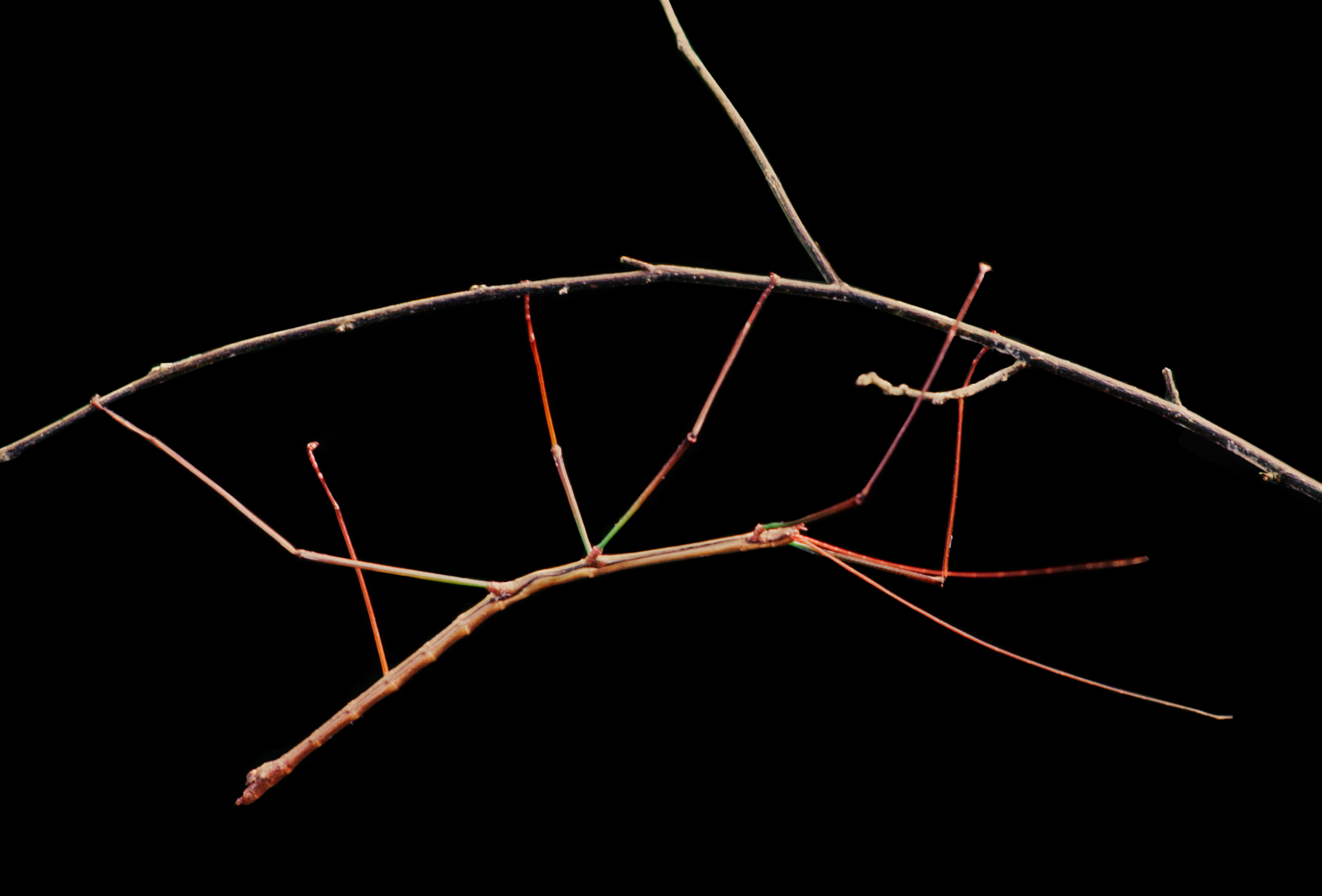
Crickets at night
Scientists have described and named more than 1 1/2 million species (kinds) of animals. Of these, about 1 million are insects. Scientists discover thousands of new species of insects every year. They believe there may be from 5 million to 30 million species still undiscovered.
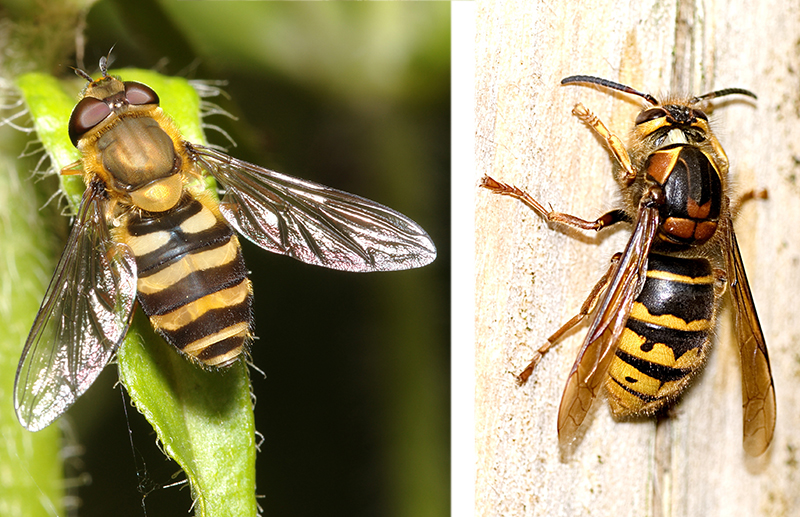
Insects live almost everywhere on Earth—from steamy tropical jungles to cold polar regions. They live high on snow-capped mountains, and in deserts below sea level. They can be found in caves deep in the earth, or flying high in the sky. Only in the oceans are few insects found.
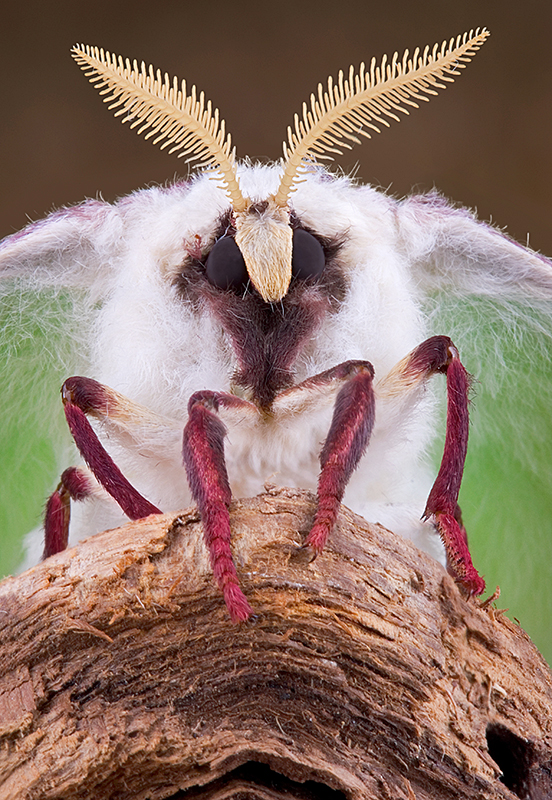
We are constantly at war with some insects. They annoy us, bite us, and infect us with deadly germs and parasites. They attack our crops, our pets, and our domestic animals. They invade our homes, eat our food, and damage our property. But insects also have great value to us. They pollinate many of our crops, provide us with such products as honey and silk, and serve as food for fish, birds, and many other animals. In fact, life as we know it could not exist if all the insects disappeared.
Insects rank among the most fascinating animals on Earth. They smell chiefly with their antennae, and some taste with their feet. Many insects hear by means of structures on their bodies called “hairs.” These structures resemble the true hairs of mammals. Other insects have “ears” on their legs or on the sides of their bodies. Insects have no voices, but some make noises that can be heard 1 mile (1.6 kilometers) away. Insects have no lungs, but breathe through holes in their sides. Some insects have no eyes, and others possess five eyes or more. Many insects have enormous strength. An ant can lift a weight 30 times as heavy as its body. If a 200-pound (91-kilogram) man could do as well, he could lift 3 tons (2.7 metric tons)—with his teeth. A flea can broad-jump about 13 inches (33 centimeters). If a human being could do as well, he or she could jump 700 feet (210 meters).
Many insects do the same things we do. They build bridges and apartment houses. Some raise crops, and others keep “cattle” that they “milk.” There are also insect carpenters, papermakers, guards, soldiers, nurses, slaves, hunters, trappers, thieves, and undertakers. Some insects even go to war against one another.
Many people think that such animals as spiders, centipedes, mites, and ticks are insects. But these animals differ from insects. For example, spiders have eight legs, and insects have six. A spider’s body is divided into two main parts, but an insect’s body has three. Most insects have wings and antennae, but spiders do not.
The world of insects
The story of insects is a tremendous success story. Insects first appeared on Earth at least 400 million years ago. Down through the ages, they have struggled endlessly to survive. During this struggle, insects have gradually developed an incredible variety of body forms and ways of life. They have adapted themselves to almost all types of living conditions.
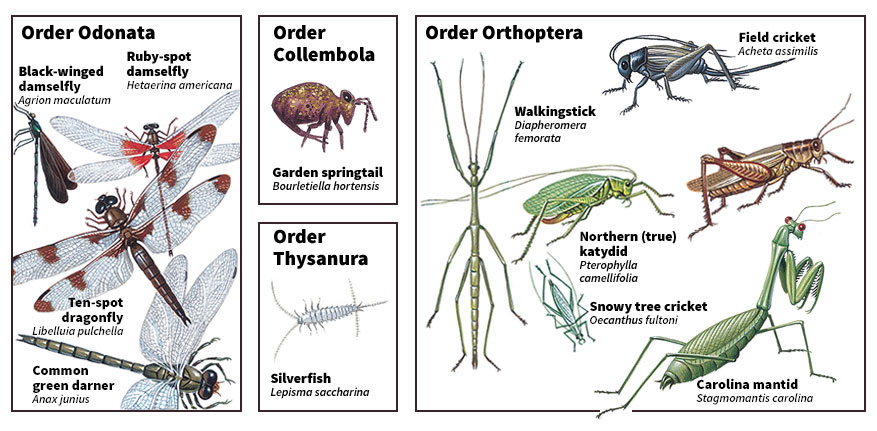
Today, there are at least four times as many kinds of insects as all other kinds of animals combined. The total number of individual insects is astonishing. Scientists estimate that the average number of insects for each 1 square mile (2.6 square kilometers) of land equals the total number of people on Earth.
About 1 million species of insects have been classified by entomologists (scientists who study insects) into major groups called orders. These orders are based on general body characteristics and other features. For example, all butterflies and moths make up the order Lepidoptera, and all beetles make up the order Coleoptera. The insect orders and the characteristics of each are given in the table The orders of insects in this article. See also the Classification, Scientific article.
The variety of insects.
The world of insects includes some of the most beautiful and fantastic animals on Earth. No other branch of the animal kingdom has such great variety in size, color, and form.

Most insects measure less than 1/4 inch (6.4 millimeters) long. The smallest ones include fairy flies and certain kinds of beetles. These insects are about 1/100 inch (0.25 millimeter) long, and they could easily crawl through the eye of the smallest needle.
Giant insects include the Goliath beetle, which grows to more than 4 inches (10 centimeters) long; certain Asian species of walkingsticks, which measure about 13 inches (33 centimeters) long; and the giant owl moth, which has a wingspread of about 12 inches (30 centimeters). A giant owl moth is about 1,200 times as large as a fairy fly.
There are insects of all colors of the rainbow. Some butterflies and moths, with their gorgeous color patterns, rank among the most beautiful of all the animals in the world. Insect collectors prize many kinds of beetles for their brilliant metallike colors. Many insects blend in with their backgrounds. For example, most of the beetles that live in the ground are either black or brown. Some kinds of moths have the color of the bark of trees.
Insects have an amazing variety of shapes and special structures. Some insects look like sticks, green leaves, dry leaves, or snail shells. Others resemble thorns, dry reeds, or bird droppings. Ichneumon wasps have an egg-laying tool up to about 4 1/2 inches (11.4 centimeters) long that can drill through solid wood. The egg-laying tool of bees, wasps, and some ants has become a sting. The eyes of stalk-eyed flies are on the ends of slender stalks. Water scorpions have a snorkellike device that they push up through the water to get air. Nut weevils have a long, slender beak—often as long as the rest of their bodies—which they use to bore into nuts. Backswimmers have long hind legs, which they use like a pair of oars. Some stag beetles have jaws as long as their bodies and branched like antlers.
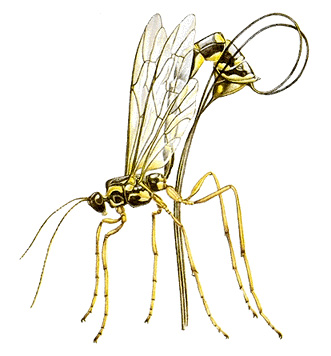
Why insects are so successful.
Insects have had such enormous success in their struggle for survival for several reasons. One is that they can adapt to even the harshest living conditions. The young of some insects live in pools of crude oil. Others live in embalming solutions. Some live in streams where the temperature falls to 32 °F (0 °C), the freezing point of water. Others live in hot springs where the temperature rises to 120 °F (49 °C). Insects have been frozen solid below 0 °F (–18 °C) and lived. Some have been put into a vacuum as great as people can create, and survived. Although most insects feed on plant life, many have adapted themselves to eating almost anything. Various kinds of insects eat fabrics, opium, mustard plaster, cork, tobacco, face powder, paste, or pepper.
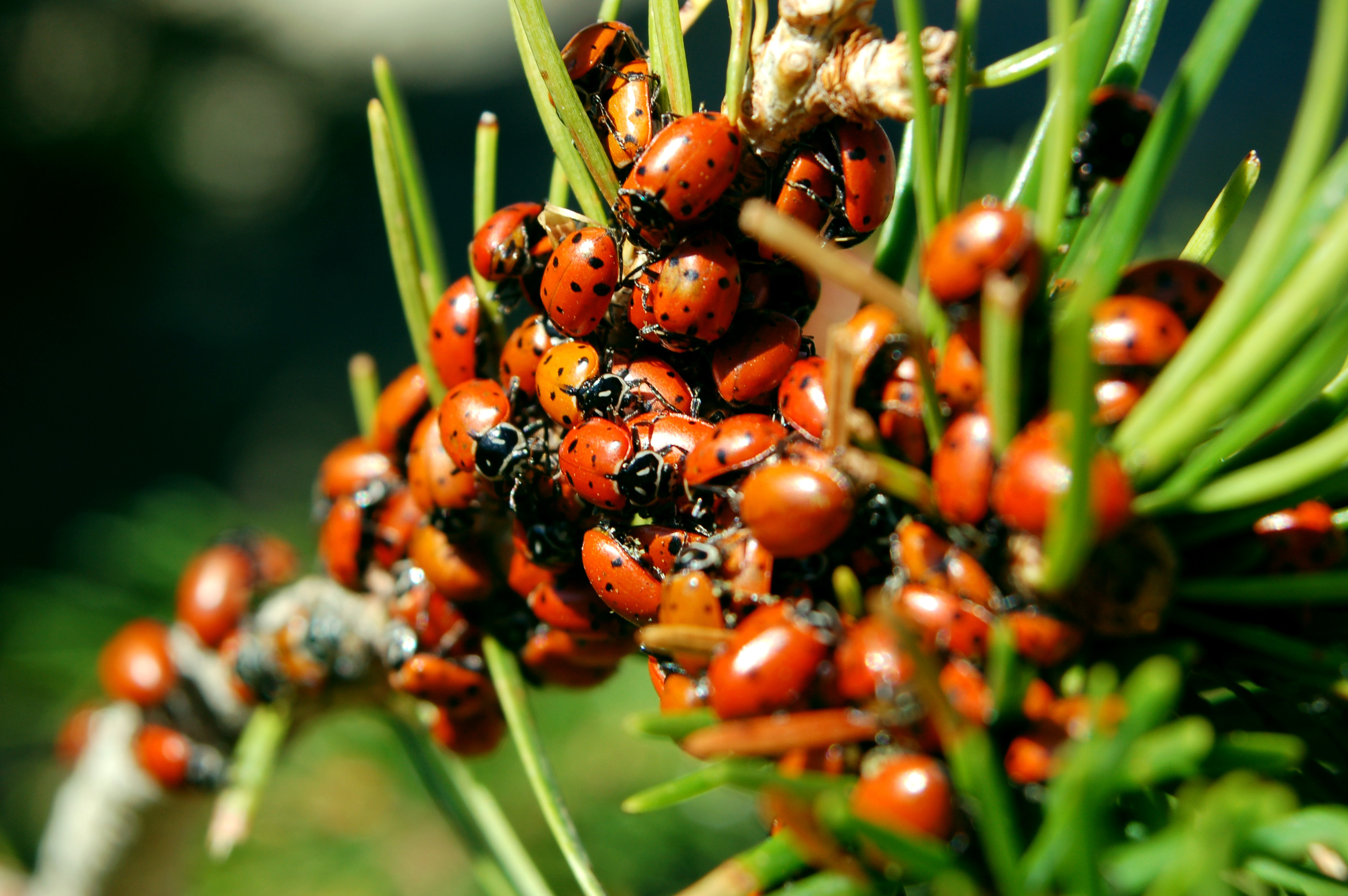
Another reason for insects’ success is their small size. Insects can live in places that are too small for other animals, and where they can also find food and protection from predators (hunting animals). Some insects live between the thin walls of a leaf. Some develop within a small seed or within the eggs of other insects. Because insects are small, they need little food. A crumb provides a banquet for an insect.
The skeleton of insects also has helped them survive. An insect has its skeleton on the outside of its body. This tough coat of armor protects the animal’s internal organs against injury and loss of moisture.
Most insects have wings, which give them a great advantage over most other kinds of animals. Flying makes it easier for insects to search for food, to escape from predators, and to find mates.
Much of the success of insects results from their powers of reproduction. Most insects have short lives. They quickly become adults and reproduce. Most insects lay many eggs. Many kinds produce several generations during a season. Because insects can reproduce so rapidly and in such great numbers, they can adapt to meet changes in their surroundings that could otherwise wipe them out. Insects also have special methods of reproduction. The females of some species can reproduce without mating. A queen honey bee, after one mating period, can lay eggs for the rest of her life.
The importance of insects
Insects are often grouped as beneficial or harmful, but this grouping is somewhat artificial. All insects form part of the great web of life that includes human beings and all other living things. Insects feed on plants and animals, but they also are food for plants and animals. Insects thus help keep in balance the total number of plants and animals on Earth (see Balance of nature). If all insects disappeared, Earth would be completely changed. People probably could not survive.
Beneficial insects
include bees, wasps, flies, butterflies, moths, and others that pollinate plants. In the United States, the value of crops that require or benefit from pollination by insects totals billions of dollars a year. Many fruits, including oranges, apples, plums, strawberries, blackberries, pears, and grapes, depend on insect pollinators for the production of seeds. So do such vegetables and field crops as peas, onions, carrots, cabbages, clover, and alfalfa. Insects also pollinate carnations, morning-glories, orchids, magnolias, and other lovely flowers. See Pollen.
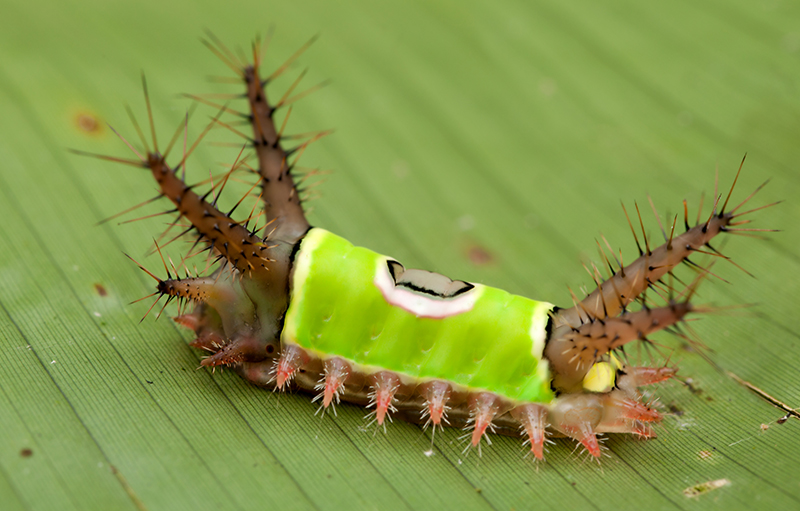
Insects are an important food source for birds, fish, frogs, lizards, skunks, and many other animals. Insects even serve as food for such plants as Venus flytraps, pitcher plants, and sundews. People also eat insects. In South Africa, some people roast termites and eat them by the handful, like popcorn. Mexicans make a cake out of the eggs of water boatmen. Many U.S. stores sell fried caterpillars and chocolate-covered bees and ants.
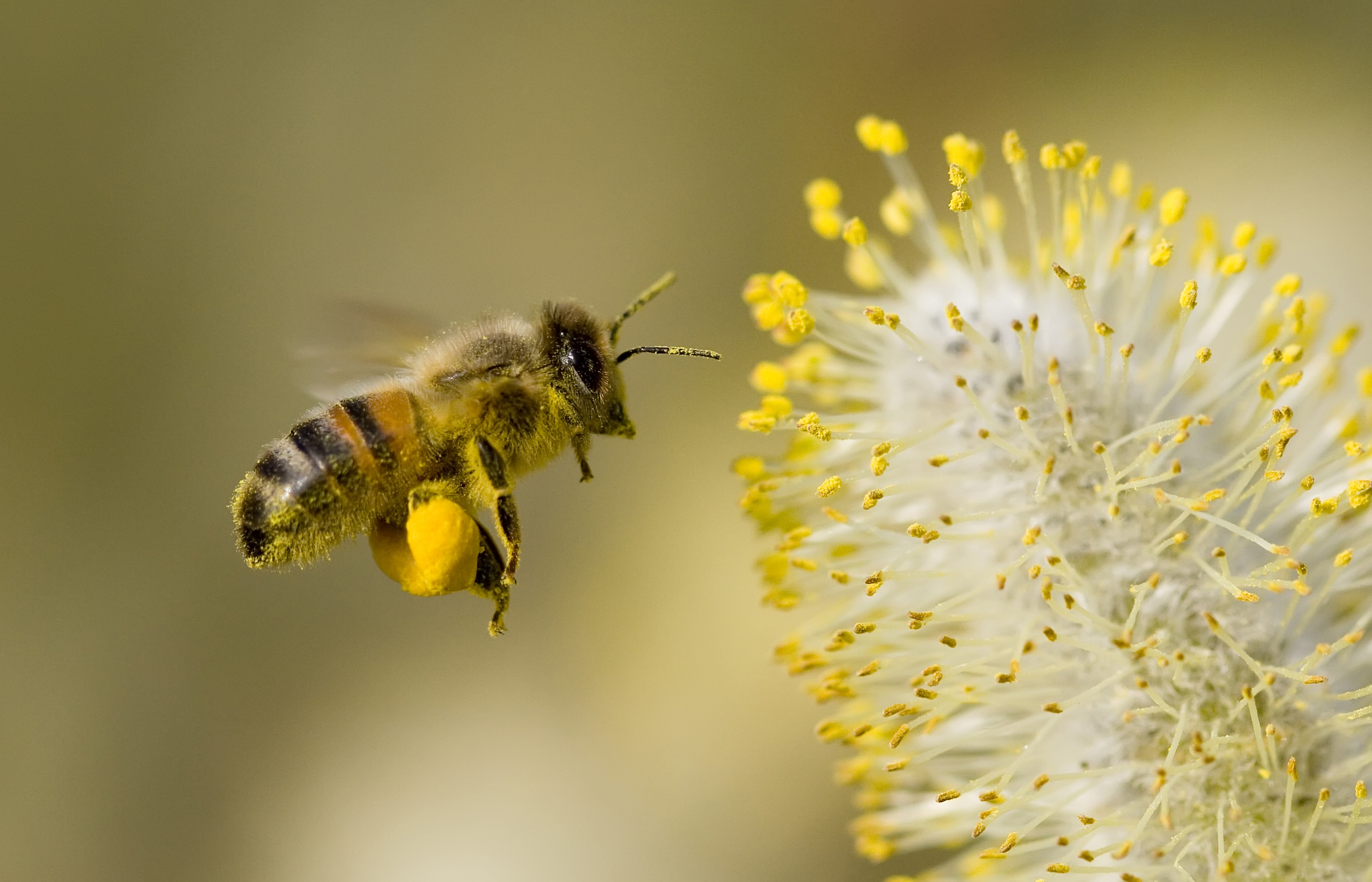
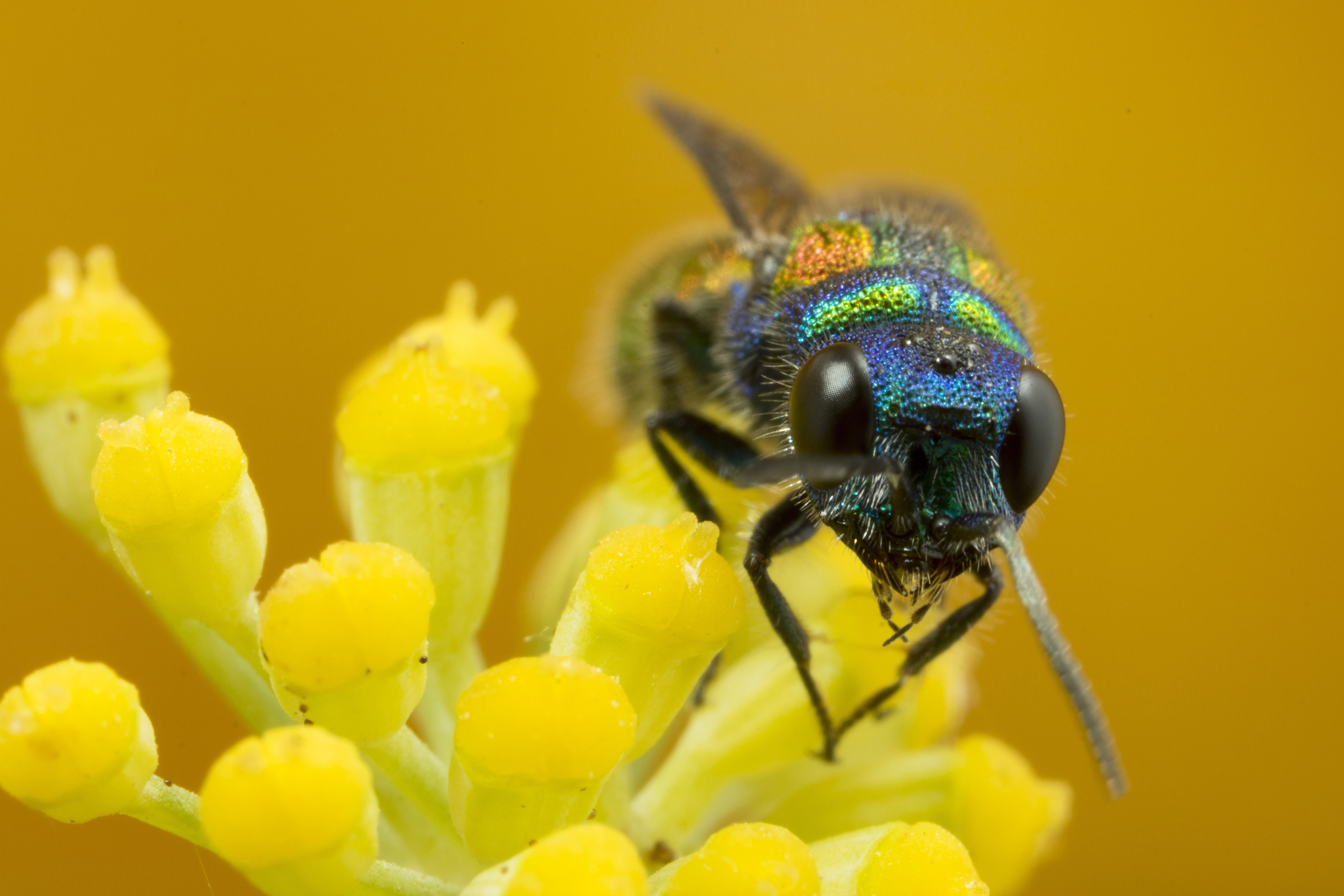
Insects provide us with products worth millions of dollars yearly. These products include honey and beeswax, made by bees; shellac, made from a substance given off by lac insects; and silk, made by silkworms.
Many insects help keep the landscape clean by feeding on animal wastes and dead animals, or the remains of dead plants. Insects that live in the ground enrich the soil with their waste products and dead bodies.
Many insects are beneficial because they are predators. They feed on harmful insects. One predator, the ladybug, eats several kinds of crop-destroying insects. Other helpful insects are the parasites that live in or on the bodies of harmful insects. For example, some wasps lay their eggs in caterpillars that damage tomato plants. As the young develop, they feed on the caterpillars and kill them.
Harmful insects.
Less than 1 percent of the estimated 1 million species of insects are harmful. Of the many thousands of species in the United States, only a few hundred are serious pests. But the damage they do and the cost of controlling them total billions of dollars yearly. Insects attack and injure almost all types of plants. Each year, insects destroy about 10 percent of the crops raised in the United States. Major pests include boll weevils and bollworms, which damage cotton; Hessian flies, which attack wheat; corn earworms and chinch bugs, which destroy corn and other crops; and Colorado potato beetles, which eat potatoes.
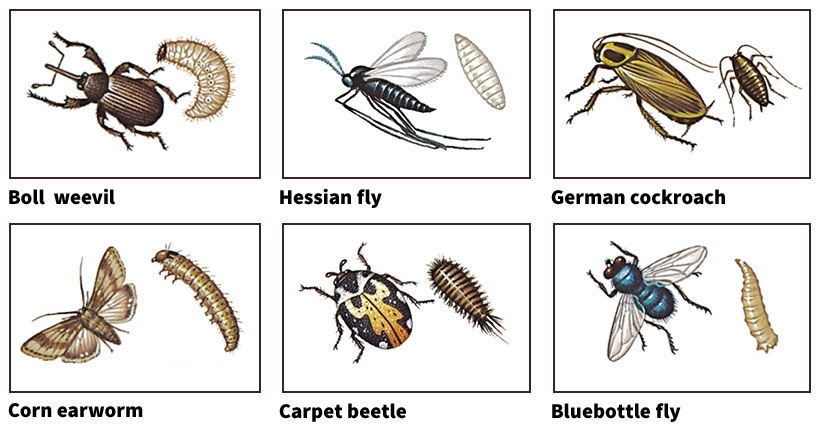
Many insects are household pests. Clothes moths and carpet beetles ruin clothing, carpets, upholstery, and furs. Silverfish damage books. Termites attack furniture and the beams and floors of buildings. Ants, cockroaches, flies, and many other insects eat or spoil the food stored in homes and warehouses.
The most harmful insects are probably those that endanger our health. Many fleas, lice, and other insect parasites may cause soreness, damage to tissues, or occasionally death. House flies and blow flies often carry germs that cause typhoid fever, cholera, dysentery, or other diseases. Many bloodsucking insects carry such deadly diseases as malaria, African sleeping sickness, or plague. In addition, the bites of numerous flies and bugs can cause persistent discomfort and even shock.
Insect control.
People use many methods to control insect pests. Some methods are simple. Flies can be swatted, or beetles merely picked off plants. The careful draining of swamps can destroy mosquito breeding places without harming many other organisms (living things). The young of house flies can be killed by burning the rubbish in which they live. Other control methods require more expertise. These include (1) quarantine systems, (2) cultural control, (3) biological control, or (4) chemical control.
Quarantine systems
try to prevent insect pests from entering a country. Pests are often imported accidentally on ships, planes, or other vehicles. In many countries, government inspectors examine baggage and cargo for pests at the borders and chief points of entry. Some of the worst imported pests include the boll weevil, Japanese beetle, spongy moth, and Hessian fly.
Cultural control
is a way of preventing insect damage through better farming methods. One method is crop rotation, which stops the increase in insects that feed on one kind of plant. Another method of cultural control is to schedule planting and harvesting so they are not done when insects lay eggs or are most numerous.
Biological control
is the use of predators, parasites, or diseases to check pests. A spectacular example of this method took place in the late 1800’s. The cottony cushion scale, an insect accidentally imported from Australia, had almost destroyed California’s lemon and orange groves. Scientists imported two of the cushion scale’s natural predators from Australia, one of which was a species of ladybug. The ladybug helped bring the scales in check within two years and saved the citrus groves. Another method of biological control sterilizes insects by radiation or chemicals so they cannot reproduce. This method was used successfully in the 1950’s against screwworms that had attacked livestock in the southeastern United States.
Chemical control
chiefly involves the use of insecticides. But most insecticides are extremely dangerous to people and tend to upset the balance of nature by destroying beneficial as well as harmful insects. In addition, some harmful insects become resistant to insecticides after a few generations. See Insecticide.
The most effective pest control plans combine more than one of these control methods. For example, integrated pest management combines cultural, biological, and chemical control methods.
The bodies of insects
Adult insects have three pairs of legs, a body divided into three main parts—head, thorax, and abdomen—and a tough shell-like outer covering. Most insects also have wings and a pair of antennae.
Skeleton
The skeleton of an insect is on the outside of its body, and is called an exoskeleton. It is made up of several substances, the best known of which is chitin. The exoskeleton is lighter and stronger than bone, and serves as a suit of armor that protects the internal organs. The insect’s muscles are attached to the inside wall of the exoskeleton.
The exoskeleton does not grow with an insect, as do the bones of a child. In time, the exoskeleton becomes too tight and must be shed. This process is called molting. The insect forms a new suit of armor underneath before it crawls out of the old suit. The new exoskeleton is soft, and so the insect gulps air to stretch it before the suit hardens. This process provides growing room until the next molt. Most insects continue to molt until they become adults.
The exoskeleton of an adult insect consists of about 20 ringlike parts. Some of these segments have become so completely fused (joined together) that they cannot be seen. Other segments are connected by flexible areas that serve as joints. The segments are grouped into the three main parts that make up the insect’s body.
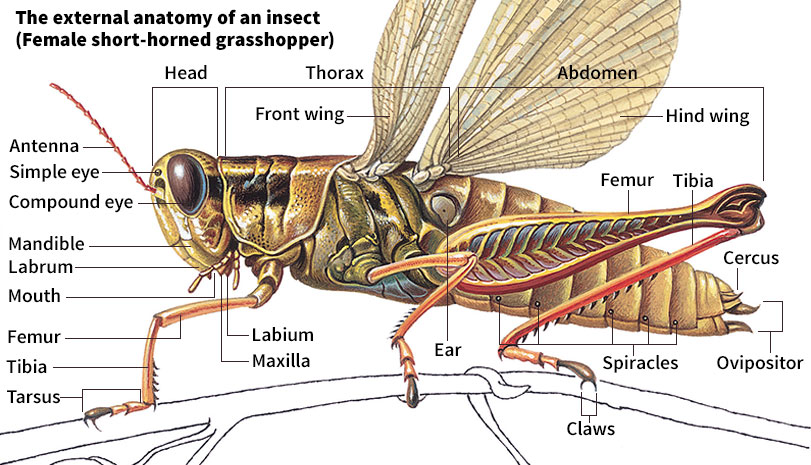
Head
An insect’s head consists of five or six segments, but they are too tightly fused to be seen. The head includes the mouthparts, eyes, and antennae.
Mouthparts
are a set of structures used for feeding. These structures surround the insect’s actual mouth, which is merely an opening in the head. The parts differ among insects, according to how the animal feeds. There are two main types of mouthparts. One type is adapted for chewing, and the other for sucking. Each order of insects has its own variation of one of these types, or a combination of both.
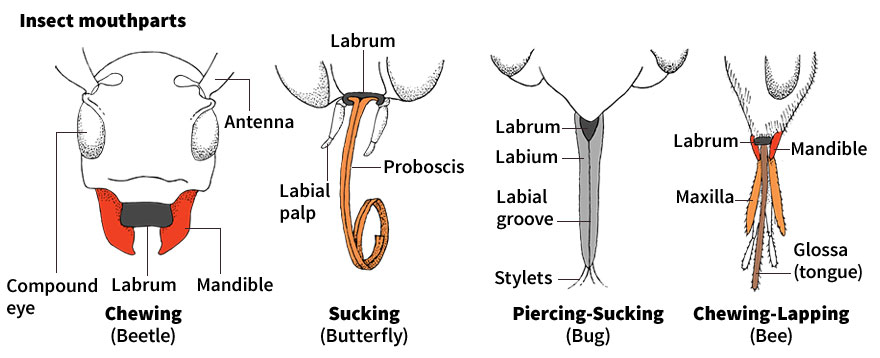
Chewing insects include grasshoppers, crickets, beetles, termites, and cockroaches. These insects have two powerful grinding jaws called mandibles. The jaws, which in most species are lined with teeth, work sideways, not up and down as ours do. An insect uses its jaws not only for chewing, but also for cutting or tearing off food. A second pair of less powerful jaws, called maxillae, is behind the mandibles. They also move sideways, and are used for handling food and pushing it down the throat. Chewing insects have two lips. The upper lip, called the labrum, is simply a flap that hangs down over the mouthparts and covers the mouth from the front. The lower lip, called the labium, covers the mouth from behind.
Sucking insects have mouthparts that developed from the basic chewing structures. The mouthparts of some sucking insects have changed so much to suit the animals’ feeding habits that they are hard to recognize. The labium of bed bugs, chinch bugs, and other bugs has become a long, grooved beak. Four slender, sharp needles called stylets lie in the groove. The stylets developed from the mandibles and the maxillae. They are used for piercing plants or animals and then sucking up the juices or blood. The labrum serves as a flap that covers the groove in the beak.
In butterflies and moths, the mandibles have almost disappeared. Parts of the maxillae have become greatly lengthened and joined together to form a long, slender drinking tube. This tube, the proboscis, coils up when the insect is not using it to suck liquids, such as nectar from flowers. In horse flies, the mandibles have become curved swords that can slash an animal’s skin. The maxillae have developed into sharp-pointed rods that can be driven up and down into the victim’s skin like a pneumatic drill. To feed, a horse fly plunges its sucking tube, formed from the labrum, into the bleeding wound made by the cutting tools.
Eyes and antennae.
Most adult insects have two enormous compound eyes. These eyes are made up of separate lenses—as many as thousands of them. All the lenses combine to form a complete picture of what an insect sees.
Almost all insects have two antennae between their eyes. They use their antennae chiefly to smell and to feel. Many also use their antennae to hear, and some use them to taste. Most insects become distressed if their antennae are damaged or removed, and some become helpless. For more information on insect eyes and antennae, see the section The senses of insects in this article.
Thorax
The thorax is the middle section of an insect’s body. It consists of three tightly fused segments. The muscles that operate the legs and wings are attached to the inside wall of the thorax.
Legs.
One pair of legs is connected to each segment of the thorax. Each leg has five main segments, with movable joints between the segments. When we walk, we balance ourselves on one leg as we step forward with the other. When insects walk, they usually move the middle leg on one side at the same time they move the front and hind legs on the other. In this way, they are always firmly supported—like a three-legged stool.

Many kinds of insects have legs adapted for special tasks. Giant water bugs, backswimmers, diving beetles, and a number of other insects that swim have long, flat hind legs that work like oars. Mole crickets and many types of dung beetles have strong, flat front legs that serve as shovels for digging. Locusts, fleas, and grasshoppers have long, muscular hind legs adapted for jumping. Honey bees have pollen-collecting brushes on their front legs and pollen-carrying baskets on their hind legs. Many kinds of butterflies have small, hairy front legs with special organs for finding food. Flies and bees have hooks and sticky pads on their feet. These insects can walk on slippery surfaces, up and down walls, and upside down on ceilings.

Wings.
Insects are the only animals besides birds and bats that have wings. Most adult insects have them. House flies, mosquitoes, tsetse flies, and all other true flies have two wings, which are attached to the middle segment of the thorax. Butterflies, dragonflies, moths, wasps, bees, and other winged insects have four wings. One pair is attached to the middle segment of the thorax, and the other pair to the hind segment.
Insects get their flying power from two sets of muscles. One set extends from top to bottom of the thorax. When these muscles contract, the thorax flattens, causing the wings to move up. The other set of muscles extends lengthwise. When they contract, the thorax arches upward, causing the wings to move down. As the two sets of muscles flatten and arch the thorax, they cause the wings to beat. Other muscles are attached directly to the bases of the wings, and control the direction of flight. They make it possible for many insects to fly in one place like a helicopter, or even to fly backward.
Among insects that have four wings, the two wings on each side often work together as if they were one wing. In some groups of insects, the two wings on each side overlap. In other groups, they lock together by means of hooks or hairs. Dragonflies beat their two pairs of wings alternately, with the front pair rising as the rear pair falls. Beetles do not use their front wings for flight. These wings form horny covers that protect the hind wings when the beetles are at rest. Flies have a pair of club-shaped balancing organs called halteres, which have replaced their hind wings. A fly usually will not try to fly if its halteres have been removed.
The fastest-flying insects are probably dragonflies. Some scientists estimate that these insects can fly as fast as 60 miles (97 kilometers) per hour. Butterflies and locusts can fly continuously for well over 100 miles (160 kilometers) on the food energy stored in their bodies. Tiny fruit flies can fly more than five hours without refueling. On the other hand, honey bees carry only enough fuel for a 15-minute flight. Large-winged butterflies beat their wings 4 to 20 times per second; house flies, about 200 times per second; and some midges, about 1,000 times per second.
Abdomen
An insect’s abdomen contains organs for digesting food, reproducing, and getting rid of waste products. The abdomen consists of 10 or 11 segments connected by flexible membranes. These membranes make it possible for the ringlike segments to slide into one another, like a telescope, when the abdomen is empty. The segments spread far apart when the abdomen is full. The abdomen of a queen termite may be so swollen with eggs that it is more than 1,000 times as large as the rest of her body. In some ant colonies, certain ants serve as food storage tanks. Their abdomens bulge with liquid sugar, with which they can feed other ants. The storage ants give up the liquid sugar through their mouths.
Many insects have a pair of feelers, called cerci, on the last segment of the abdomen. Mayflies, stone flies, and some cockroaches have especially long cerci. The cerci of earwigs and some other insects form a pair of tongs that are used for defense or for capturing prey.
The outer reproductive organs are attached to the eighth and ninth segments of the abdomen. In many males, these organs are part of a set of structures that hold the female during mating. The organs of many females are part of an egg-laying tool called the ovipositor. Females use the ovipositor to insert their eggs into such things as soil, wood, leaves, fruits, seeds, or the eggs or bodies of other animals. Some females have an ovipositor as long as or longer than the rest of the body. The ovipositor of bees, ants, and wasps has been adapted into a sting that can be withdrawn into the abdomen when not in use. Near the end of the abdomen is an opening called the anus, through which wastes and extra water pass from the insect’s body.
Internal organs
The internal organs of insects, like those of other animals, are grouped into various systems. But these systems differ in many ways from those of other animals. The chief systems are the circulatory, respiratory, nervous, muscular, digestive, and reproductive systems.
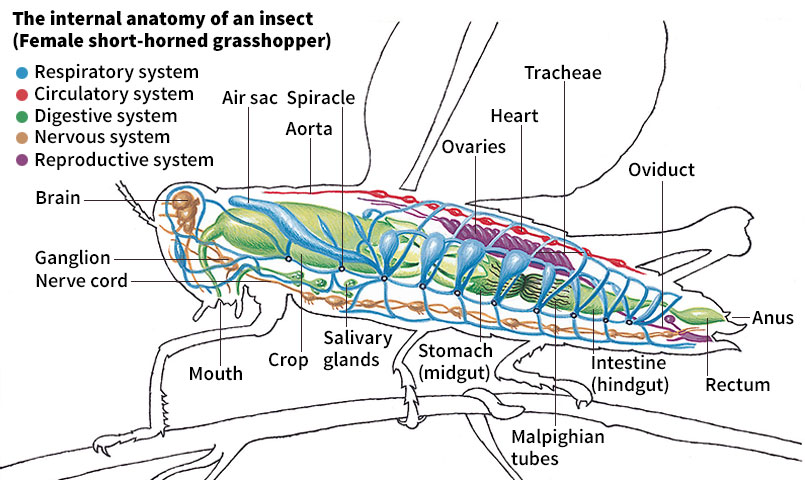
Circulatory system
carries blood through the body. An insect’s blood does not flow through veins and arteries as ours does. Blood fills the whole cavity of the insect’s body, and bathes all the organs and muscles. The blood is circulated by a long tube that lies just under the exoskeleton of the back. This tube extends almost the entire length of the body. The pumping part of the tube lies in the abdomen, and is called the heart. The front part of the tube extends into the head, and is called the aorta. Blood enters the tube through little openings, called ostia, along the sides. The openings have valves that allow blood to enter the tube, but not to flow out. As the heart contracts, the blood is forced along the tube and out through the aorta. The blood first bathes the brain, and then flows to other parts of the body. It then reenters the tube through the ostia.
An insect’s blood, like ours, carries food and waste products to and from the cells of the body. But unlike our blood, it has nothing to do with bringing oxygen to the cells. Our blood contains a red pigment called hemoglobin, which carries oxygen to the cells. Nearly all insects do not have hemoglobin in their blood, and most insect blood is greenish, yellowish, or colorless.
Insects are cold-blooded animals. That is, the internal temperature of their bodies varies according to the temperature of the surrounding air. Insects cope with heat and cold in many ways. Strongly flying insects must have high body temperatures to fly. Large ones, such as hawk moths, bumblebees, and large beetles, raise their body temperatures by “shivering”—that is, by working their wing muscles against one another without actually flying. Smaller insects, such as many butterflies, flies, and grasshoppers, may absorb sunlight to become warmer.
Respiratory system.
An insect breathes by means of tiny holes, called spiracles, along the sides of its body. Each hole leads into a large tube called a trachea. The large tubes divide into small tubes, which, in turn, divide into still smaller tubes that branch out to all the cells of the body. This system of tubes carries oxygen to the cells and takes away carbon dioxide.
Nervous system
consists of a brain, located in the head, and two nerve cords that lie side by side along the floor of the thorax and abdomen. The brain receives information from the eyes and antennae, and controls the insect’s body activities as a whole. Another nerve center in the head is connected to the brain and controls the insect’s mouthparts. Each of the two nerve cords contains a cluster of nerve cells, called a ganglion, in each segment of the thorax and abdomen. The two ganglia in each segment are fused and form a sort of little brain that controls the activities of that segment. The ganglia often can work without the brain. For example, many insects that have had their heads cut off can still walk, mate, and lay eggs. In some insects, the three pairs of ganglia in the thorax are fused into one. Various pairs of ganglia in the abdomen also are fused in many insects.
Muscular system
is made up of several hundred to a few thousand small but very strong muscles. Grasshoppers have about 900 muscles, and caterpillars have from 2,000 to 4,000. Human beings have fewer than 700 muscles. Many insects can lift or pull an object 20 or more times heavier than the weight of their bodies. Few people can lift a weight heavier than the weight of their bodies.
Digestive system
of an insect consists basically of a long tube that extends from the mouth to the anus. The tube has three main divisions. They are (1) the foregut; (2) the midgut, or stomach; and (3) the hindgut, or intestine.
In insects that have chewing mouthparts, the food is chewed up and then enters the foregut through the mouth. The food moves along the tube until it reaches an enlarged area called the crop, where it is temporarily stored and partly digested. Then the food passes into the gizzard, which has thick muscular walls that contract and grind the food into small bits. The gizzard of some insects has teeth that help break up and grind the food. The food next passes into the midgut, where most digestion takes place. Nourishing parts of the food are absorbed into the blood, and wastes and undigested parts enter the hindgut. Insects with sucking mouthparts have a similar digestive process. But they suck up—rather than chew up—their food, and they often lack a gizzard.
Almost all insects have a system of 2 to over 250 Malpighian tubes attached to the digestive system where the midgut and hindgut join. The tubes absorb waste materials from the blood. The waste passes through the tubes into the hindgut. All wastes and extra water that enter the hindgut leave the body through the anus.
Reproductive system.
Most insects reproduce sexually. That is, a new individual can be created only after a female sex cell, called an egg, has united with a male sex cell, called a sperm. The reproductive organs are in the abdomen. Females have two organs, called ovaries, in which eggs develop. A tube called an oviduct carries the eggs away from each ovary. The two oviducts join and form a single tube that opens near the tip of the abdomen. Male insects have two organs, called testicles or testes, that produce sperm. A tube carries the sperm from each testicle. The two tubes unite and form a single tube that extends to the outside of the abdomen.
The senses of insects
Like other animals, insects have organs that allow them to see, hear, touch, taste, and smell. Many kinds of insects have senses that are far keener than those of most other animals.
Sight.
Most kinds of insects have two large compound eyes that occupy most of the head. Each eye is made up of tiny six-sided lenses that fit together like the cells of a honeycomb. The number of lenses varies from about 6 in some worker ants to about 30,000 in some dragonflies. Each lens admits a small part of the total scene that the insect sees. All the parts together combine and form the whole picture.

Insects cannot move or focus their eyes. They have sharp vision for only a short distance. They see objects more than 1 yard (0.9 meter) away as a blur. But insects can quickly see movements, and many can tell colors apart. Many insects also can see a broader range of light rays than people can. For example, some beetles can see infrared, and most insects can see ultraviolet light. Both are invisible to people. Insects have no eyelids. Their eyes are always open.
Many adult insects have three simple eyes, called ocelli. These eyes are set in the form of a triangle between the compound eyes. The simple eyes cannot form images. They can only tell the difference between light and dark. The young of many insects lack compound eyes, but they have from one to six or more simple eyes on each side of the head.
Hearing.
Insects have a wide range of hearing. Some can hear ultrasonic sounds more than two octaves higher than people can hear. Other insects respond to sounds so low that the human ear cannot hear them. Yet only a few kinds of insects have true hearing organs, or “ears.” These ears are located almost anywhere on the body, but never in the head. They consist simply of thin, flat membranes that vibrate when sound waves strike them, just as our eardrums do. Short-horned grasshoppers, locusts, cicadas, and many moths have their ears on the sides of the body. Long-horned grasshoppers and crickets have theirs on the front legs.
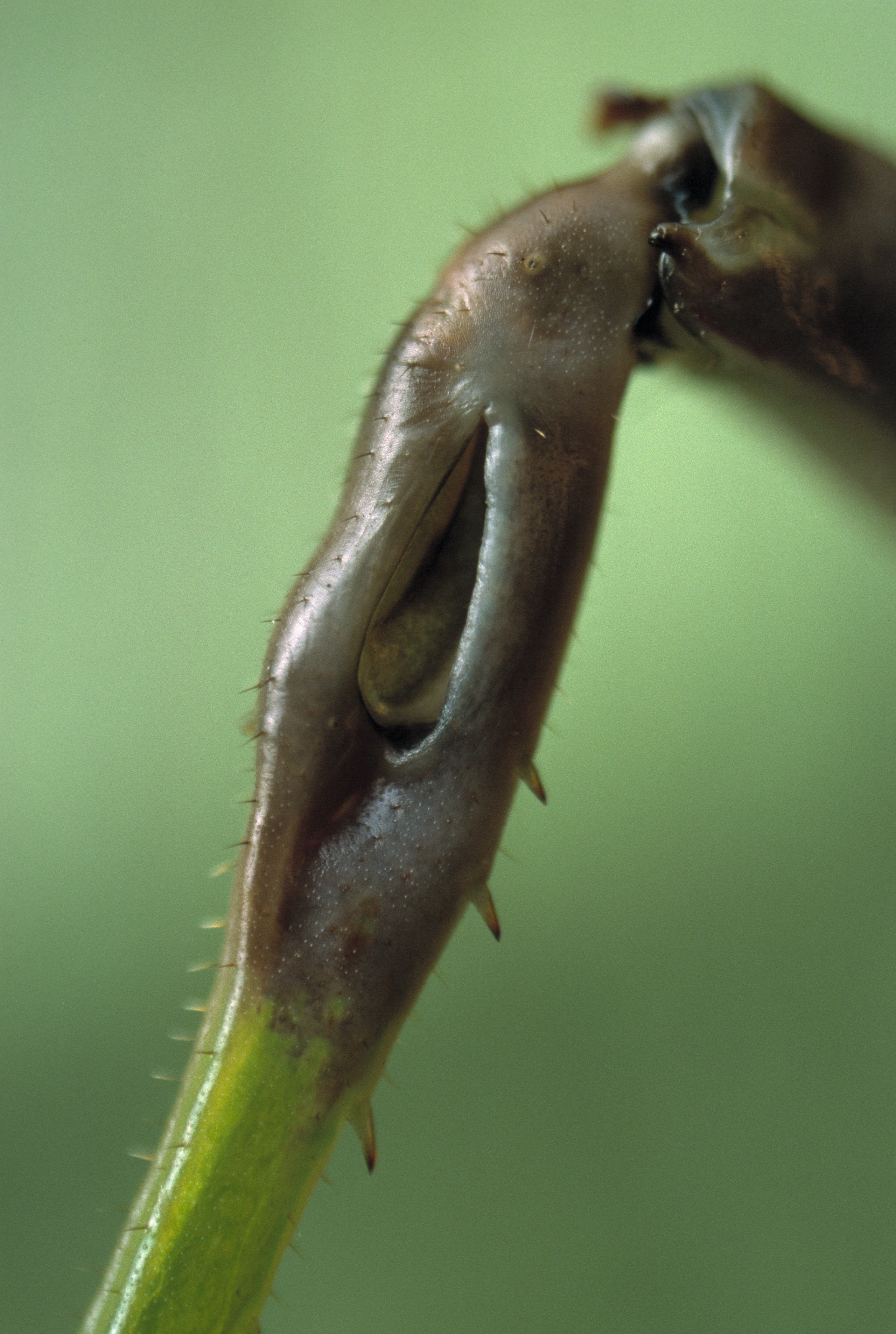
Most insects do not have ears. They hear by means of the delicate hairs on their antennae or elsewhere on the body. These hairs respond to sound waves, just as they do to other movements in the air. Male mosquitoes have long hairs on their antennae that cause the antennae to vibrate rapidly to sound waves. Some ants also hear by means of the hairs on their antennae. Cockroaches hear with the hairs on their cerci, the pair of feelers on the last segment of the abdomen. Caterpillars hear with hairs scattered over the whole body.
Although insects can hear, they do not have voices. Many of them make sounds by stridulating—rubbing one part of the body against another part. Grasshoppers, crickets, and cicadas are probably the noisiest insects. Usually, only the adult males stridulate. They “sing” to attract the females, most of which can make no sound. Short-horned grasshoppers stridulate by rubbing a hind leg against a vein in a forewing, much as a violinist draws his bow across the strings. Crickets sing by scraping their leathery front wings together. In Portugal, Japan, China, and some other countries, people keep crickets in cages for their cheerful songs. Cicadas have two drumheads on their abdomens, which they vibrate by means of muscles inside their bodies.
Many beetles also make sounds by scraping parts of their bodies together. In addition, they make whirring and buzzing noises with their wings. June beetles make sounds by blowing air out through their spiracles. The hum of flies and bees is made by the rapid vibration of their wings. Male mosquitoes are particularly sensitive to the notes given off by the beating wings of females, and will fly to the females to mate.
Touch.
Insects are highly sensitive to touch, much more than people are. The touch organs consist of hairs and spines that cover all parts of an insect’s body, even its eyes. The hairs are especially plentiful on the antennae. Any kind of pressure moves the hairs, setting up a nerve reaction that goes to the brain. Some of the hairs are so sensitive that the gentlest air current can bend them. No matter how carefully you move your hand toward a fly, the insect will dart off almost every time. Its hairs warn the fly that the air is being moved. 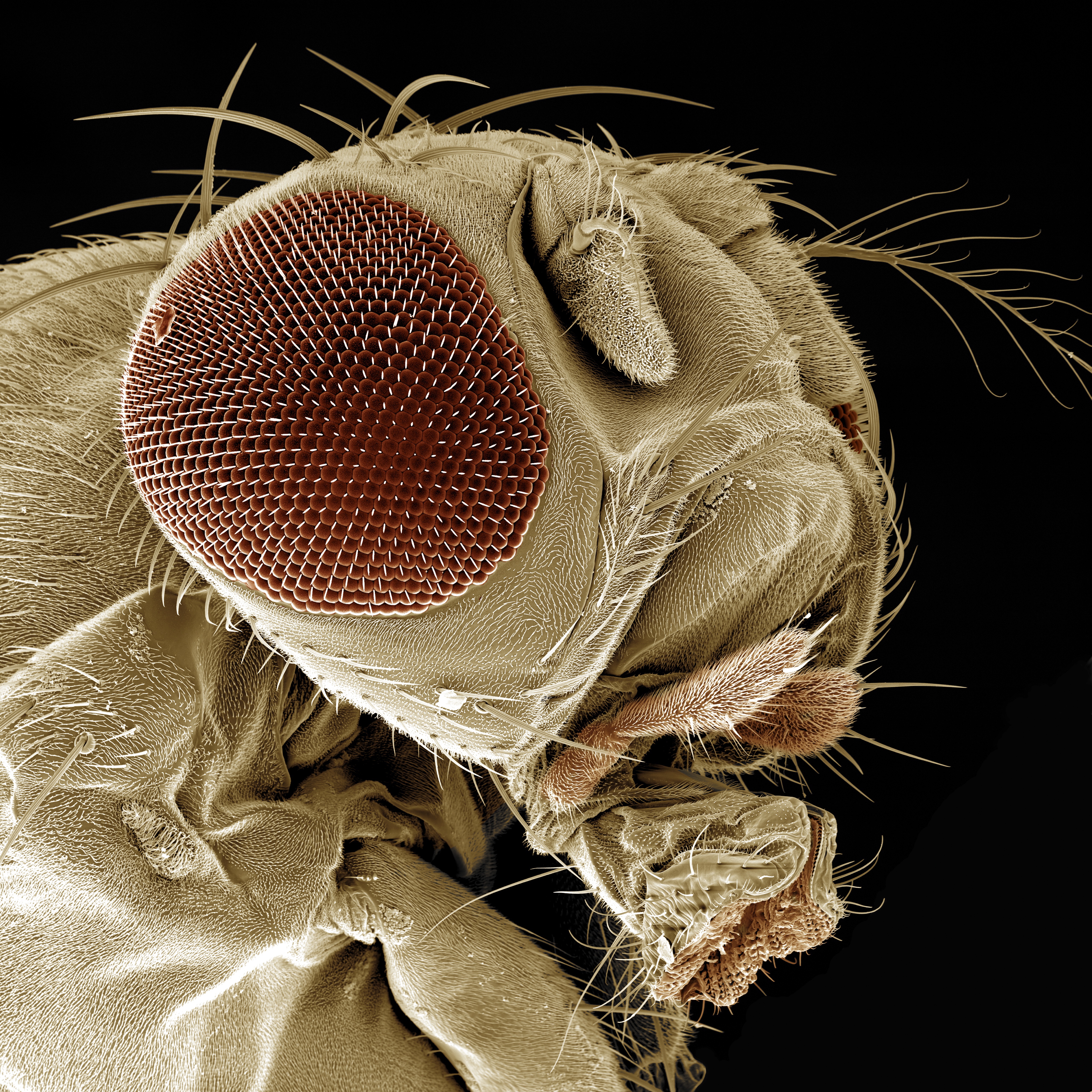
Taste.
Many insects are sensitive to the same four taste sensations—sweet, sour, salt, and bitter—that people are. The tasting ability of insects varies among species. Some insects have an amazingly sharp sense of taste. For example, the amount of sugar in water that a monarch butterfly can taste would have to be increased 2,000 times before a person could taste it.
The taste organs of most insects are on their mouthparts. Some kinds of insects, including ants, bees, and wasps, also have taste organs on their antennae. They touch food with their antennae, and eat it if they like the taste. Other insects, including butterflies, some moths and flies, and honey bees, taste with their feet. They immediately extend the proboscis to feed if they step on something tasty. Some wasps and crickets have taste organs on the ovipositor, which they use to taste the places where they lay their eggs.
Smell.
The sense of smell is located chiefly in the antennae of insects. Most species have a keen sense of smell. Insects use their sense of smell to locate food, to find their way about, and to locate places to lay their eggs. They also use it to recognize insects of their own kind and to find mates. Ants and bees recognize the members of their colony by their odor. Ants will drive away or kill an ant from another colony if it tries to enter their colony. But ants that normally fight one another will feed together peacefully if their antennae are removed. Male moths depend chiefly on their sense of smell to find mates. They can be attracted by the odor of a female moth more than 1 mile (1.6 kilometers) away. But they lose all interest in her if their antennae are removed.
The life cycle of insects
Every insect starts life as an egg. After hatching, the insect begins to grow and develop into an adult. During this process, most insects go through a series of fantastic changes in form. The entire cycle—from egg to adult—takes only a few days for some species and as long as 17 years for others. As adults, most insects live only a short time. Few kinds live more than a year. Adult mayflies probably have the briefest lives—only a few days or hours. On the other hand, queen termites may live more than 20 years. Among some species of insects, many generations are born and die in one year. Other species have only one generation a year.
Reproduction
Among most species of insects, a new individual is created when a sperm of the male fertilizes an egg of the female. The female receives the sperm during mating and stores them in her abdomen. Later, when she lays her eggs, the sperm enter the eggs as they leave her body.
Many insects have unusual ways of reproducing. Some roaches, flies, beetles, and other insects give birth to living young. The females keep the fertilized eggs inside their bodies until they hatch. Female aphids, gall wasps, thrips, and many other insects can reproduce without fertilization by the male. In fact, males are extremely rare or unknown among some species of insects. Some females, including queen honey bees, receive their lifetime supply of sperm during a single mating period. Thereafter, if the female fertilizes the eggs, only females will be born. If she does not fertilize them, only males will be produced.
Insect eggs have a variety of shapes and color patterns, but most are oval or round and are white or cream colored. The eggs of the smallest insects can be seen only under a microscope. The largest insects lay eggs from one-fourth to one-half of an inch (6.4 to 13 millimeters) long. The number of eggs laid varies from one species to another. A female insect probably lays an average of 100 to 200 eggs during her lifetime. Some females lay only a few dozen eggs. Others may lay millions of eggs. Termites are the champion egg layers. After mating, some queen termites become helplessly swollen with eggs, which they produce at a rate of 10,000 to 30,000 or more a day. Insects lay their eggs singly or in batches. They usually deposit them on or near food, which the young feed on after they hatch.
There have been many stories about the tremendous reproductive ability of insects, and of what would happen if none of the young insects died. In four months, for example, a pair of house flies could produce about 190,000,000,000,000,000,000 descendants—if all of them lived. But this could not happen. Parasites, predators, the food supply, and other factors prevent such a population explosion among insects, just as they do among other animals.
Growth and development
After an insect hatches, it follows one of three patterns of growth and development, depending on its species. The simplest pattern occurs in a few kinds of primitive wingless insects, including silverfish and springtails. When these insects hatch, they look exactly like their parents, except for size. The young insects live in the same surroundings and eat the same food in the same way as the adults. They grow to adulthood by splitting the old exoskeleton when it becomes too tight and wiggling out of it. After the insects reach a certain size and their reproductive organs have fully developed, they can mate. From the time they hatch until they die, these insects change little, except to grow larger.
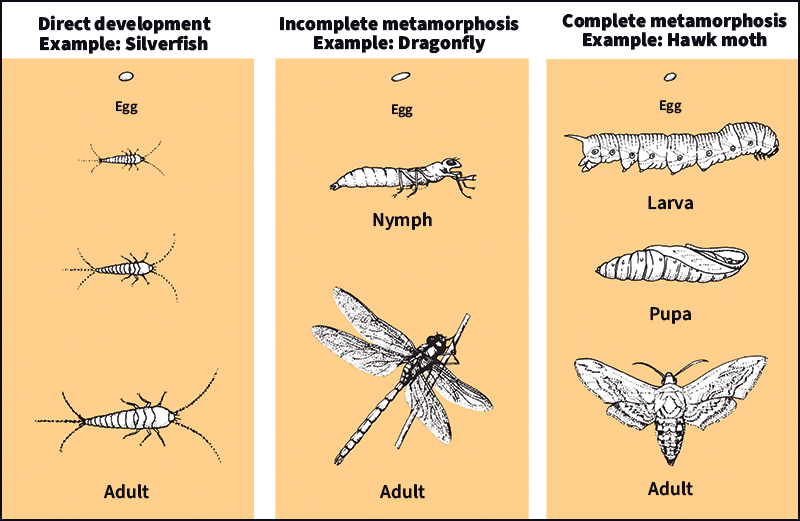
Other insects have a far different pattern of growth and development. The young look different from their parents, and are called nymphs or larvae. They change in form as they develop into adults. This change is called metamorphosis. An insect goes through one of two types of metamorphosis, incomplete or complete.
Incomplete metamorphosis
occurs in such insects as chinch bugs, cicadas, cockroaches, damselflies, dragonflies, grasshoppers, and mayflies. These insects pass through three stages: (1) egg, (2) nymph, and (3) adult.
Among such insects as grasshoppers and chinch bugs, the nymphs look much like their parents, except that they have no wings. The wings first appear as little pads after the insect has shed its exoskeleton a few times. With each molt, the wings enlarge. After the last molt, the adult comes out with its wings fully developed. The nymphs usually live in the same places and eat the same food as the adults.
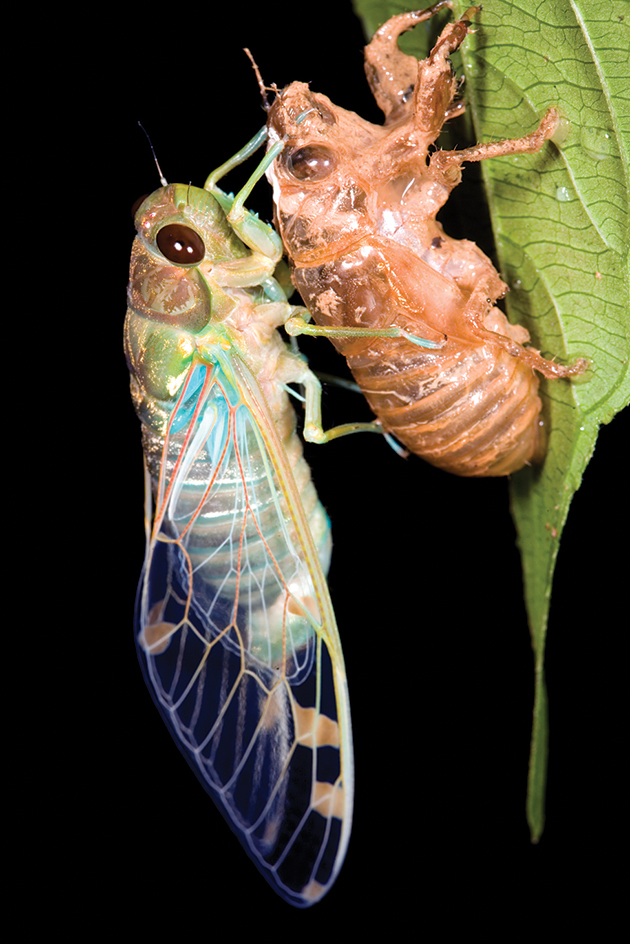
Among dragonflies and damselflies, the nymphs differ greatly from their parents. The adults are beautiful winged insects that spend much of their time in flight. The wingless nymphs live in water and breathe by means of gills. The nymphs are often called naiads. After they reach full growth, they crawl out of the water onto a plant stem or rock. They then shed their shells for the last time and become winged adults.
Complete metamorphosis
takes place in most species of insects, including butterflies, moths, beetles, flies, bees, wasps, and ants. These insects go through four stages: (1) egg, (2) larva, (3) pupa, and (4) adult. The larvae of these insects are wormlike creatures that look completely different from their parents. Among many species, the larvae live in different places and eat different foods. They do not have their parents’ compound eyes and wings. Most of them have chewing mouthparts, though their parents may have sucking mouthparts. Some larvae have no legs. Others may have many extra leglike structures on the abdomen. The larvae of many species have special names. For example, the larvae of butterflies and moths are called caterpillars; those of flies, maggots; those of beetles, grubs; and those of mosquitoes, wrigglers. Larvae simply eat and grow, molting several times as their skin becomes too tight. In one day, a caterpillar may eat several times its weight in leaves.
After a larva completes its growth, it stops eating. It then becomes a pupa. In preparation for this stage, some larvae spin a cocoon or form some other protective covering around their bodies. Most pupae lie quietly and appear lifeless. But inside the protective covering there is great activity. The larval structures are being broken down—largely into a liquid—and re-formed into adult organs. After the change is complete, the pupal covering cracks open and the adult insect crawls out. See Metamorphosis.
The ways of life of insects
An insect’s life is filled with danger. The insect may be eaten by another insect, a bird, or some other animal. People may crush, burn, or poison it. A parasite may feed on it, or a disease may strike it. A dry spell may wither the plants on which the insect feeds, causing it to starve. Cold weather may kill it. And if the insect and too many others of its species survive these dangers, their food supply will run out—and the insect will die anyway.
Loading the player...Praying mantis eating a caterpillar
Insects have developed many ways of life in their endless battle for survival. They have adapted themselves to almost all kinds of living conditions, and have developed many ways to outwit predators. Many species depend almost entirely on their high rate of reproduction to survive the hazards of life. In fact, most insects spend most of their time eating and reproducing. Almost everything else they do is related to those two activities.

Courtship.
Insects attract mates in many ways. Among many kinds of moths, the females give off an odor that attracts males, often across long distances. The males of many species of butterflies also have scent organs that they use to attract females. Male grasshoppers, crickets, cicadas, and katydids “sing.” Male tree crickets also give off a liquid from behind their wings, which the females feed on. Male dance flies usually bring the females gifts of captured insects. Among some species of fireflies, the females give off a flashing light in the form of code signals to attract males. The males of some other species flash their light and then wait for the females to give an answering flash.

Family life.
Most kinds of insects have no family life. The parents get together only to mate. The females simply lay their eggs where the developing young will have food, and then leave them. Many wasps and bees store food with their eggs. Parasitic wasps and flies lay their eggs on or near other insects or animals. The horse botfly glues her eggs to the hairs of a horse where they can be licked off by the horse. The larvae grow and develop in the horse’s stomach, and are discharged with waste matter. The females of a number of species give their eggs or young some care. Earwigs keep their eggs clean, guard them until they hatch, and then watch over the young. A few kinds of beetles and bugs also stay with their young after they are born, guarding and feeding them.
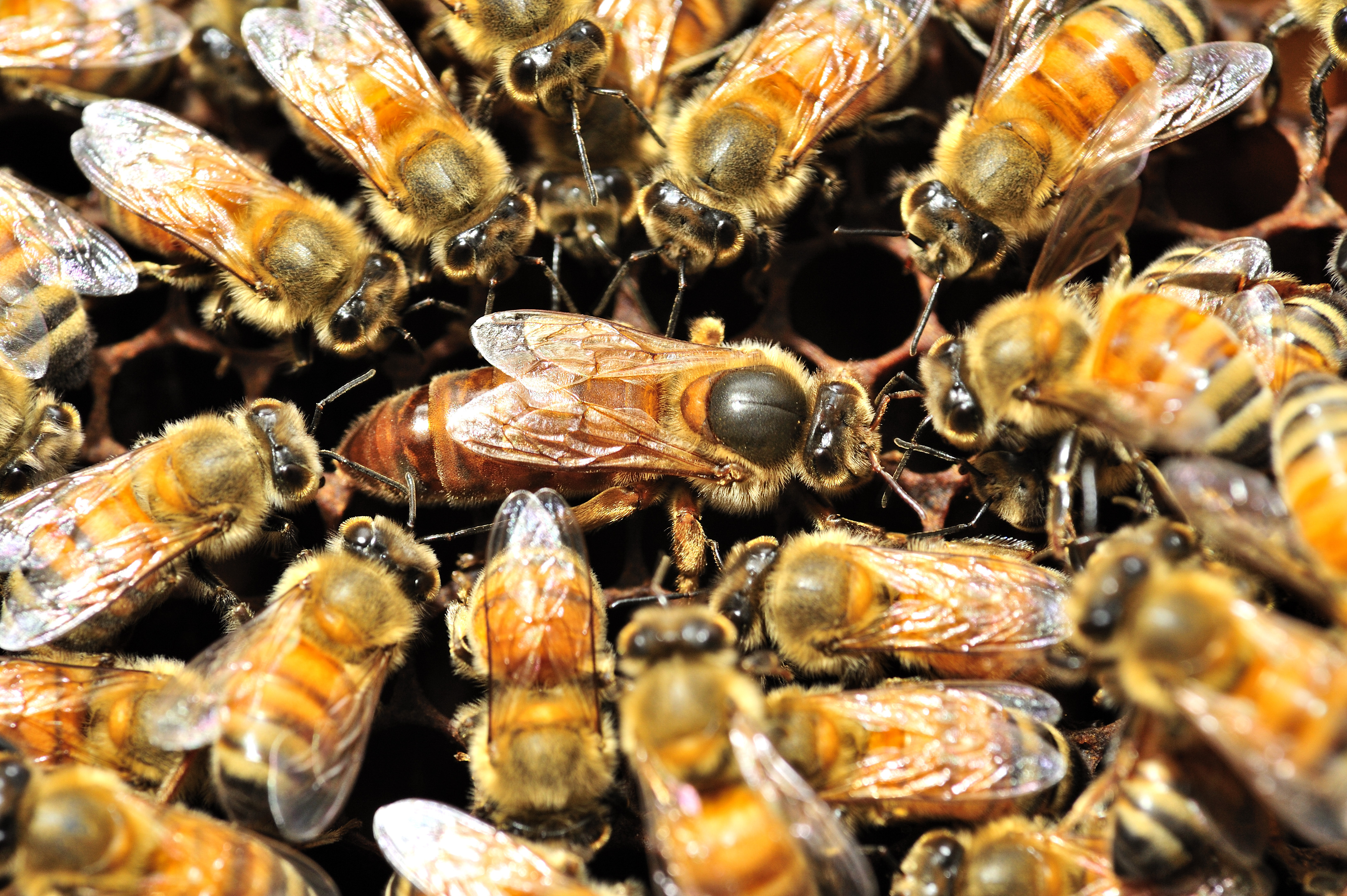
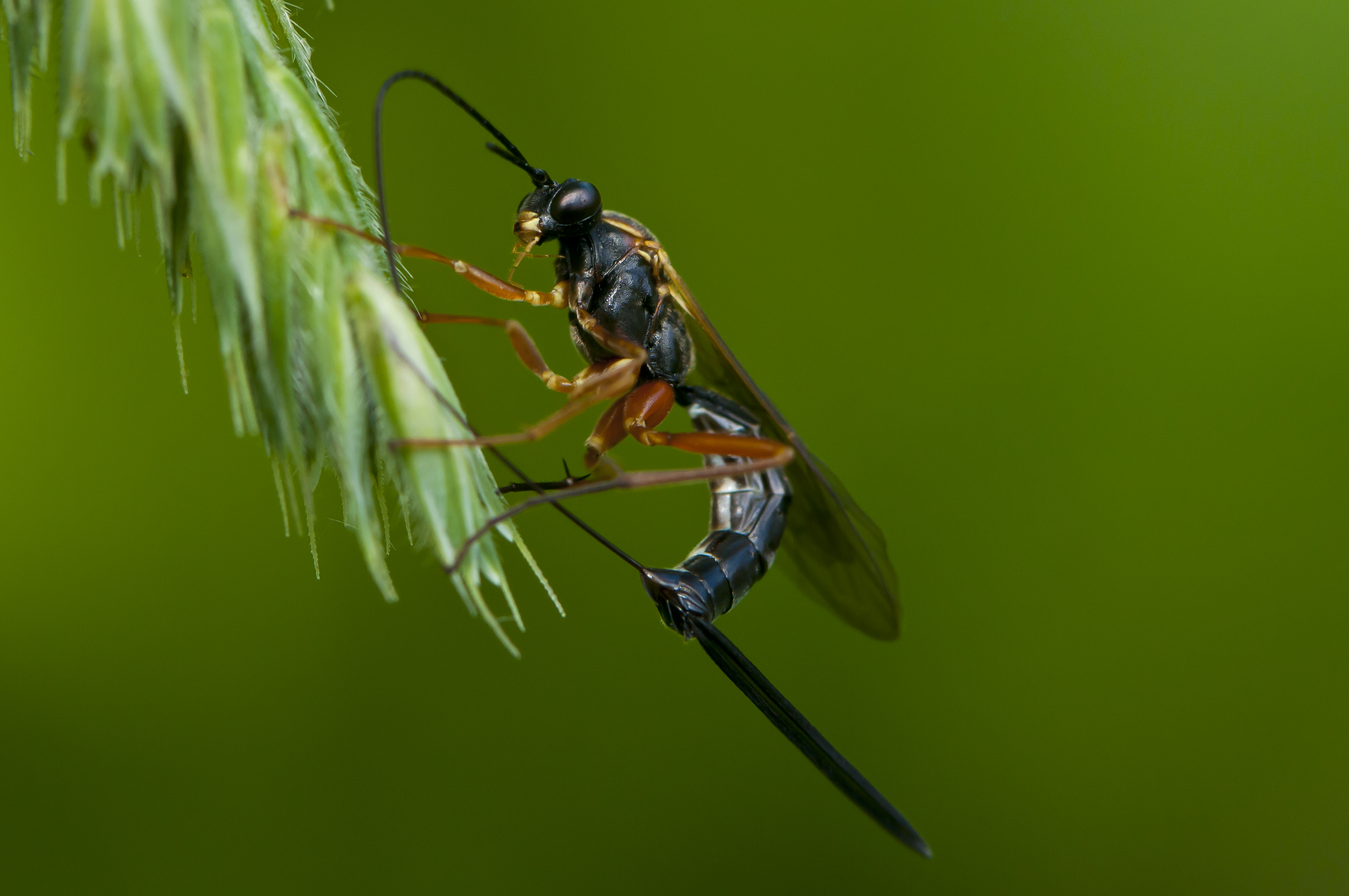
Only the true social insects have a real family life. All termites, all ants, many bees, and some wasps are social insects. They live in organized communities in which the members depend on one another. These communities are really overgrown families. For example, the 60,000 to 80,000 bees in a hive are all the offspring of one queen. So are the millions of termites that may make up a termite colony. The queen’s job is simply to lay eggs. The adults in the colony feed and care for the young. Most of the adults cannot reproduce, and are called workers. Termites have both male and female workers, and there is also a permanent reproductive male, or “king,” in each termite colony. But all the workers among ants, bees, and wasps are females. These insects have males in their colonies only at certain times. The males’ only job is to mate with the queen, after which they soon die. The workers in a colony have different tasks. Nurses look after the young, and soldiers defend the colony from attacks by predators. Some workers search for food, and others enlarge and clean the nest. 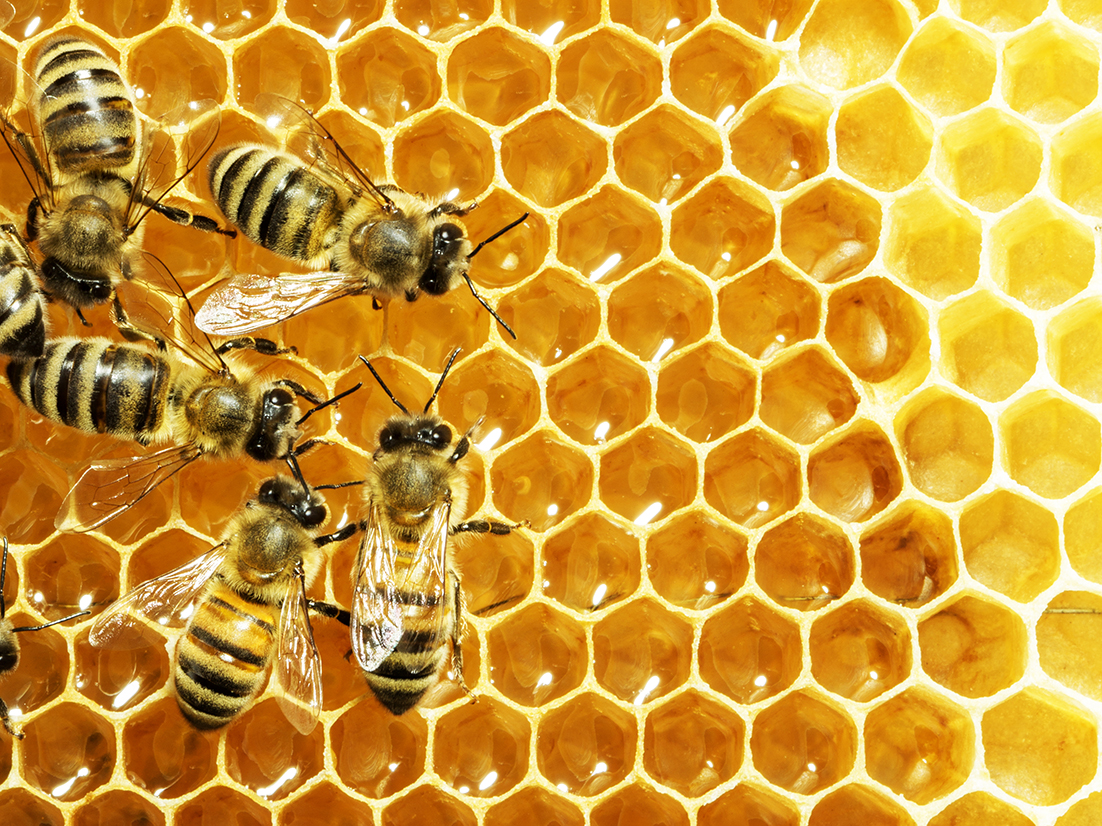
Ants are probably the most successful social insects. They have developed many different ways of life. Some kinds of ants keep aphids or other insects, which the ants “milk” for their sweet liquid. Harvester ants collect seeds and store them in their nests. Some other species actually grow their own food by cultivating tiny mushroom gardens in their nests. Thief ants live by stealing food from other ants. Many ants raid other ants’ nests and carry off the young, which they bring up as slaves. Army ants live chiefly by hunting other insects. They march across the land by the hundreds of thousands, eating all the insects they meet. They also attack mice, lizards, or any other animal that they can surround through a series of flanking movements. If the animal cannot escape through the encircling wall of ants, it is quickly torn to bits. 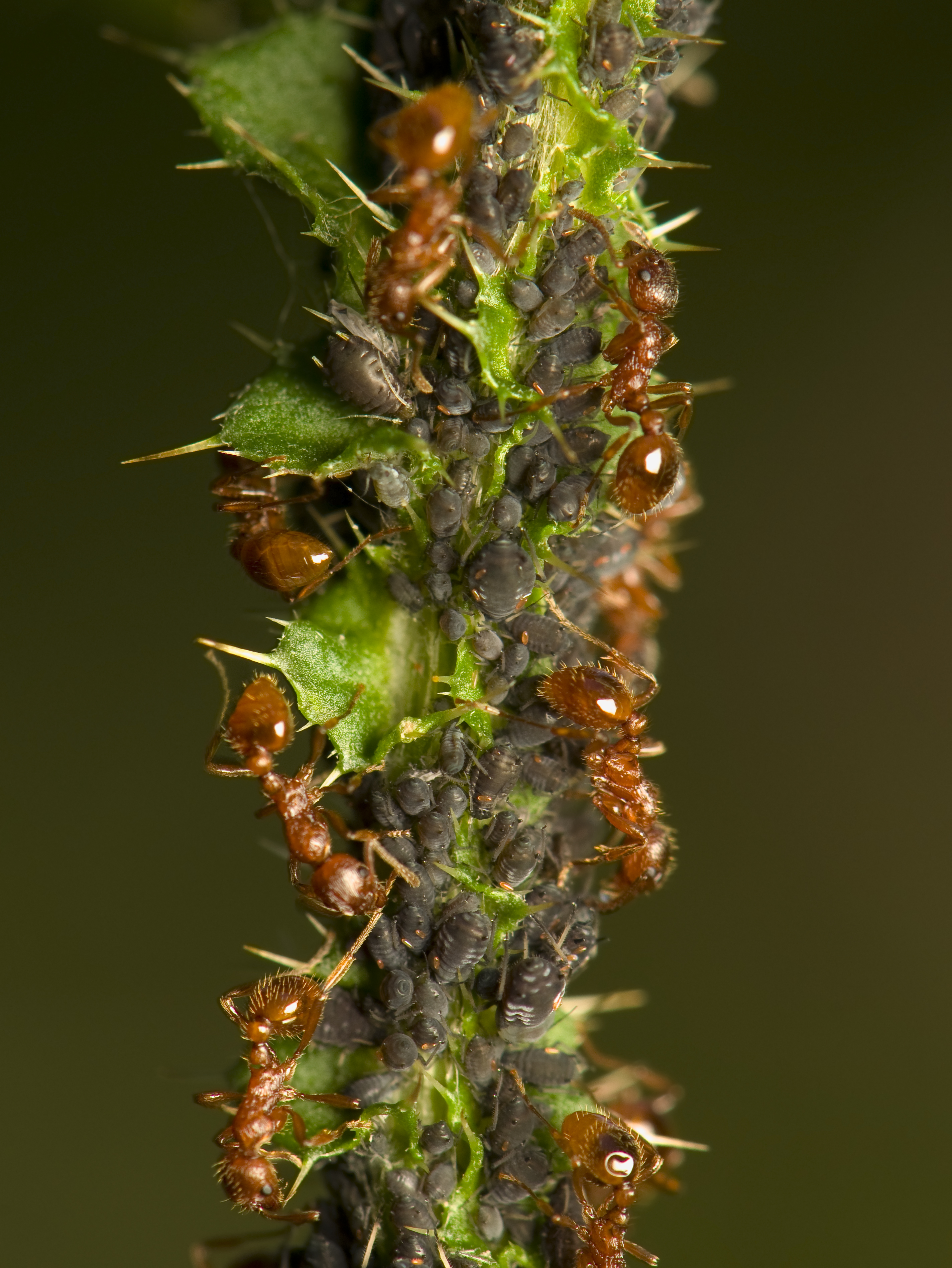
Social insects communicate with one another by the use of sound, touch, and scent. Honey bees use a dance to tell other members of the hive the direction and distance of a food supply.
Hibernation and migration.
Many insects die when winter approaches. But many others live through the cold by hibernating in the egg, larval, or pupal stage. A number of adult insects, including house flies, mosquitoes, ladybugs, and some moths and butterflies, also hibernate. They spend the winter in barns, cellars, attics, caves, holes in trees, burrows in the ground, or other protected places.
Every fall, North American monarch butterflies gather in great clouds and fly south to spend the winter in tropical or subtropical areas. In spring, they drift northward again, laying eggs as they go. Few of them live long enough to complete the return trip. Their offspring, after becoming adults, continue the northward journey. Painted ladies and several other species of butterflies also migrate with the seasons, as do some species of moths.
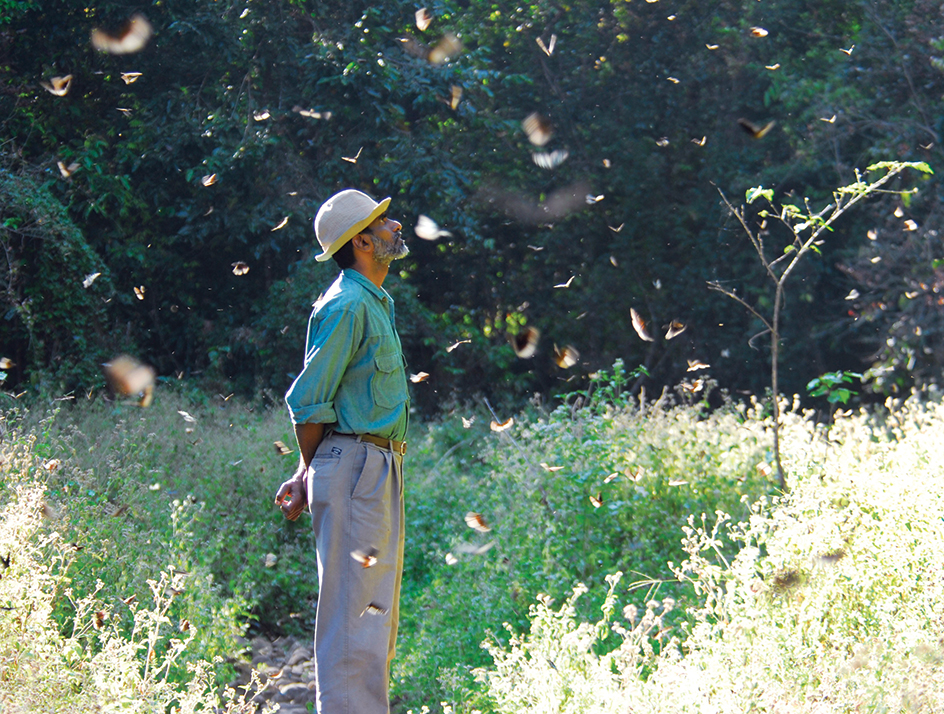
Many other insects also make long migratory flights. The most famous are probably the locusts. They often travel in swarms so huge that they black out the sun. Scientists do not know why locusts migrate, except that they do so after building up an enormous population. Locusts do not migrate because they are hungry. In fact, they may leave a land of plenty and not stop to feed during most of their long flight. But after they settle down, they destroy every bit of plant life.
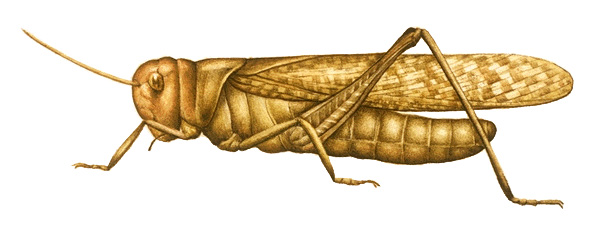
Protection from predators.
Insects have many means of self-defense against predators. Most simply try to escape, and quickly fly, leap, or scamper away. Many caterpillars and beetles play dead, or they adopt a threatening posture that may frighten a predator.
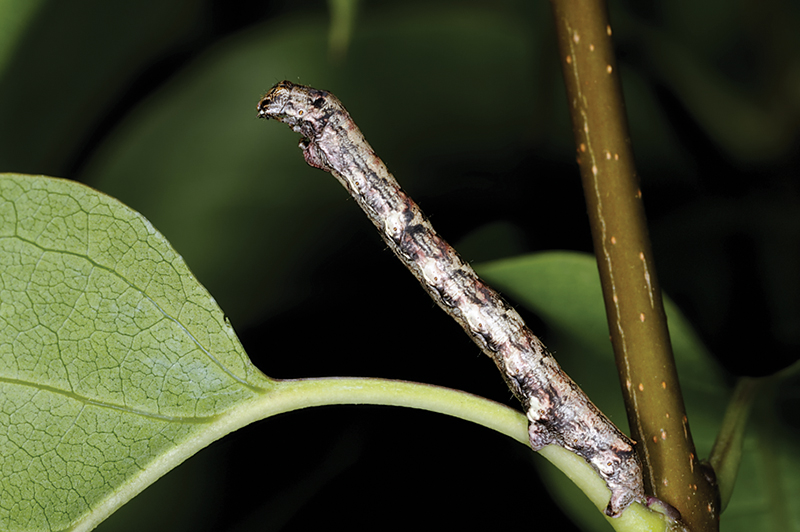
A great number of insects have powerful weapons for defense. Some can wage chemical warfare. Bombardier beetles, earwigs, walkingsticks, cockroaches, and many other insects use a harmful spray against predators. Stink bugs, lacewings, and carrion beetles give off foul odors. Some ants, stag beetles, and other insects have powerful jaws that can pinch painfully. Bees, wasps, and some ants have stings. Some caterpillars have hollow hairs filled with poison. These hairs break at the slightest touch, releasing the poison. Some butterflies, moths, and other insects are protected simply because they taste bad to birds or other predators.
Many insects escape from predators because their color or form blends with their surroundings. When resting on tree trunks, many moths look like bark or bird droppings. Walkingsticks and many caterpillars resemble twigs. When a leaf butterfly’s wings are folded, the insect looks like a dead leaf.
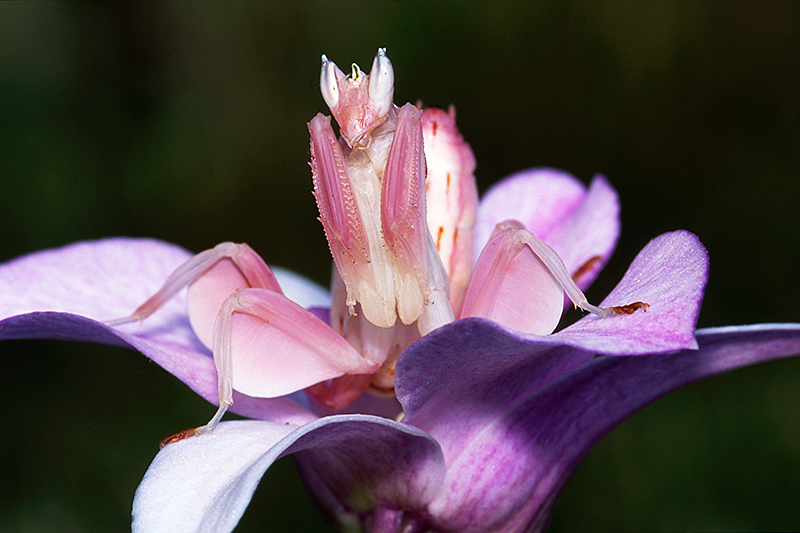
Some insects with such powerful defensive weapons as stings or chemical sprays have bright color patterns. For example, many bees and wasps have yellow and black stripes. No animal that has attacked one will want to try again. The warning colors make it easy for predators to remember that these insects are dangerous.
Some insects that do not have protective devices resemble those that do, and their predators are deceived and avoid them. Such insects are called mimics. Common mimics include certain hover flies, beetles, and drone flies that look like bees or wasps. A species of grasshopper in southeast Asia closely resembles tiger beetles. Many animals avoid the tiger beetle because it is a fierce predator. Many animals likewise avoid the grasshopper, though it poses no actual threat. Some well-protected insects even resemble other well-protected insects. Many unrelated wasps have the same black and yellow bands on their abdomens. By mimicking each other, protected insects gain even more protection. See Mimicry; Protective coloration.
Why insects behave as they do.
The lives of most insects are too short for the young to learn from their parents. In many cases, the adults have died by the time the young are born. Yet a young insect does not have to be taught what to do. The insect’s behavior patterns are inherited and built firmly into its nervous system. Every insect reacts automatically to its surroundings. If a lamp is turned on, a moth will fly toward it, but most cockroaches will run for cover. The odor of overripe fruit attracts fruit flies, and the heat given off by warm-blooded animals attracts fleas.
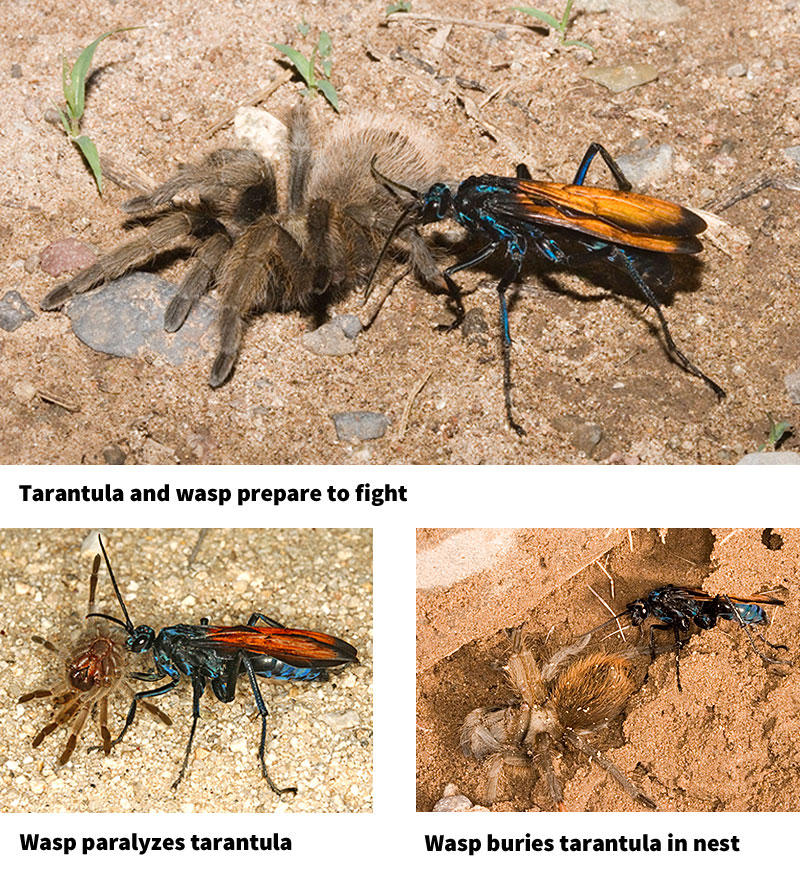
Insects often appear to be intelligent and to know what they are doing. When a female solitary wasp is ready to reproduce, for example, she looks for the right place to build a nest. After the nest has been built, she searches for the proper prey—usually a spider or caterpillar. Using her sting, the wasp paralyzes the victim and carries it to the nest. The wasp then lays an egg on the prey, which the larva will feed on after the egg hatches. Finally, the female seals and camouflages the nest. The wasp does all this automatically. She does not have to learn how.
Insects do have some ability to learn. A honey bee can learn to associate a color with food, and to recognize landmarks around its hive. But generally, each insect of each species acts entirely according to its inherited behavior patterns. These patterns, like the insect’s body structures, have developed through the centuries in the struggle of the species to survive.
The orders of insects
Insects belong to the phylum Arthropoda, a basic division of the animal kingdom that also includes centipedes, crabs, and spiders. The phylum is divided into several classes. Insects make up the class Insecta. This class is further divided into orders of insects according to various characteristics. These characteristics include the presence or absence of wings, the structure of the wings and mouthparts, and the type of metamorphosis.
Entomologists do not agree on the number of insect orders. This section lists orders for all major insect groups. The orders are arranged according to the evolutionary development of insects. Orders of primitive wingless insects whose structure and habits have changed little over time are at the beginning of the list. The most highly developed orders appear at the end, though it is difficult to say which orders are the most specialized.
The first insects were wingless and appeared at least 400 million years ago. They may have evolved from wormlike creatures or from animals with lobelike legs. By about 300 million years ago, many insects had developed wings. Some early insects were immense. One species of dragonfly had a wingspread of at least 2 feet (61 centimeters). By the beginning of the Cretaceous Period, about 145 million years ago, all present-day insect orders had appeared.
To learn where insects fit into the whole animal kingdom, see Animal (table: A classification of the animal kingdom).
